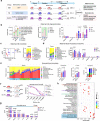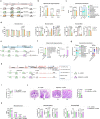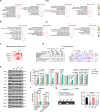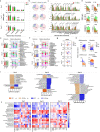Sialic acid-based probiotic intervention in lactating mothers improves the neonatal gut microbiota and immune responses by regulating sialylated milk oligosaccharide synthesis via the gut-breast axis
- PMID: 38630006
- PMCID: PMC11028031
- DOI: 10.1080/19490976.2024.2334967
Sialic acid-based probiotic intervention in lactating mothers improves the neonatal gut microbiota and immune responses by regulating sialylated milk oligosaccharide synthesis via the gut-breast axis
Abstract
Human milk oligosaccharides (HMOs) are vital milk carbohydrates that help promote the microbiota-dependent growth and immunity of infants. Sialic acid (SA) is a crucial component of sialylated milk oligosaccharides (S-MOs); however, the effects of SA supplementation in lactating mothers on S-MO biosynthesis and their breastfed infants are unknown. Probiotic intervention during pregnancy or lactation demonstrates promise for modulating the milk glycobiome. Here, we evaluated whether SA and a probiotic (Pro) mixture could increase S-MO synthesis in lactating mothers and promote the microbiota development of their breastfed neonates. The results showed that SA+Pro intervention modulated the gut microbiota and 6'-SL contents in milk of maternal rats more than the SA intervention, which promoted Lactobacillus reuteri colonization in neonates and immune development. Deficient 6'-SL in the maternal rat milk of St6gal1 knockouts (St6gal1-/-) disturbed intestinal microbial structures in their offspring, thereby impeding immune tolerance development. SA+Pro intervention in lactating St6gal1± rats compromised the allergic responses of neonates by promoting 6'-SL synthesis and the neonatal gut microbiota. Our findings from human mammary epithelial cells (MCF-10A) indicated that the GPR41-PI3K-Akt-PPAR pathway helped regulate 6'-SL synthesis in mammary glands after SA+Pro intervention through the gut - breast axis. We further validated our findings using a human-cohort study, confirming that providing SA+Pro to lactating Chinese mothers increased S-MO contents in their breast milk and promoted gut Bifidobacterium spp. and Lactobacillus spp. colonization in infants, which may help enhance immune responses. Collectively, our findings may help alter the routine supplementation practices of lactating mothers to modulate milk HMOs and promote the development of early-life gut microbiota and immunity.
Keywords: Sialic acid; gut microbiota; gut–breast axis; immune response; infant; milk oligosaccharide; probiotic.
Conflict of interest statement
No potential conflict of interest was reported by the author(s).
Figures






Similar articles
-
Alterations of milk oligosaccharides in mothers with gestational diabetes mellitus impede colonization of beneficial bacteria and development of RORγt+ Treg cell-mediated immune tolerance in neonates.Gut Microbes. 2023 Dec;15(2):2256749. doi: 10.1080/19490976.2023.2256749. Epub 2023 Sep 23. Gut Microbes. 2023. PMID: 37741825 Free PMC article.
-
Maternal high-fat diet during lactation reduces sialylated milk oligosaccharides and shapes early-life microbiota in rat offspring.Food Funct. 2025 Jun 16;16(12):5123-5132. doi: 10.1039/d5fo00559k. Food Funct. 2025. PMID: 40468776
-
Microbiota from human infants consuming secretors or non-secretors mothers' milk impacts the gut and immune system in mice.mSystems. 2024 Apr 16;9(4):e0029424. doi: 10.1128/msystems.00294-24. Epub 2024 Mar 26. mSystems. 2024. PMID: 38530054 Free PMC article.
-
Studies and Application of Sialylated Milk Components on Regulating Neonatal Gut Microbiota and Health.Front Nutr. 2021 Nov 10;8:766606. doi: 10.3389/fnut.2021.766606. eCollection 2021. Front Nutr. 2021. PMID: 34859034 Free PMC article. Review.
-
Factors affecting early-life intestinal microbiota development.Nutrition. 2020 Oct;78:110812. doi: 10.1016/j.nut.2020.110812. Epub 2020 Mar 25. Nutrition. 2020. PMID: 32464473 Review.
Cited by
-
The neonatal gut microbiome in health and disease.Gut Microbes. 2025 Dec;17(1):2457499. doi: 10.1080/19490976.2025.2457499. Epub 2025 Jan 27. Gut Microbes. 2025. PMID: 39868670 Free PMC article. No abstract available.
-
Effects of maternal allergy and supplementation with ω-3 fatty acid and probiotic on human milk oligosaccharides.Pediatr Allergy Immunol. 2025 Aug;36(8):e70162. doi: 10.1111/pai.70162. Pediatr Allergy Immunol. 2025. PMID: 40747696 Free PMC article. Clinical Trial.
-
Targeted Intervention Strategies for Maternal-Offspring Transmission of Christensenellaceae in Pigs via a Deep Learning Model.Adv Sci (Weinh). 2025 Aug;12(31):e03411. doi: 10.1002/advs.202503411. Epub 2025 Jun 10. Adv Sci (Weinh). 2025. PMID: 40492389 Free PMC article.
References
-
- Brink LR, Mercer KE, Piccolo BD, Chintapalli SV, Elolimy A, Bowlin AK, Matazel KS, Pack L, Adams SH, Shankar K. et al. Neonatal diet alters fecal microbiota and metabolome profiles at different ages in infants fed breast milk or formula. Am J Clin Nutr. 2020;111(6):1190–1202. doi:10.1093/ajcn/nqaa076. PMID: 32330237. - DOI - PMC - PubMed
-
- Cowardin CA, Ahern PP, Kung VL, Hibberd MC, Cheng J, Guruge JL, Sundaresan V, Head RD, Barile D, Mills DA. et al. Mechanisms by which sialylated milk oligosaccharides impact bone biology in a gnotobiotic mouse model of infant undernutrition. Proc Natl Acad Sci U S A. 2019;116:11988–11996. doi:10.1073/pnas.1821770116. PMID:31138692. - DOI - PMC - PubMed
Publication types
MeSH terms
Substances
LinkOut - more resources
Full Text Sources
Miscellaneous
